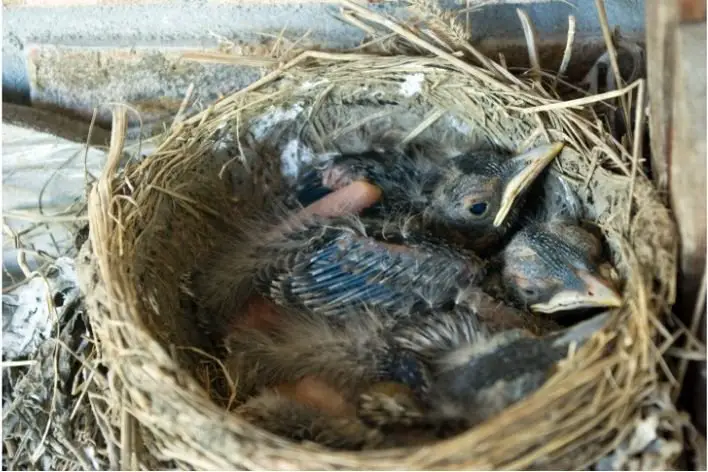Nestling baby robins are entirely dependent on their parents for the first 1-2 months of their life. They rely on them primarily for food, shelter and safety. Having said this, robins have an extremely high mortality rate, with up to 70% of robins dying before they reach one year old. A female robin will lay between 10 and 18 eggs per year, with a likelihood that only 3-5 of them will become a fully-fledged adult robin.
How Long Do Nestling Baby Robins Stay In Their Nest?
- The female robin lays 4-6 eggs in her nest
- After 10-14 days, the eggs hatch and the robins are called nestlings
- After 9-16 days, the nestlings leave the nest for the first time, and become ’fledglings’
- The fledglings are still looked after by the male adult robin for another 10-15 days before becoming fully independent
Robin Nesting
When an adult robin is nesting, she lays approximately one egg per day for between 4-6 days. The eggs can take up to a fortnight to hatch, and will be closely monitored by the adult robins during this time.
Female robins will have 2-3 nestings per year, each of them likely to be fathered by the same male robin. In between breeding seasons, the partner is likely to change.
Nestlings
‘Nestlings’ are baby robins that are newly hatched. Robins are nestlings for anywhere between 9-16 days. While a baby robin is in this stage it won’t leave the robin nest, and relies heavily on its parents for food. During this stage, nestling baby robins are vulnerable to sickness caused by parasites. They do not have any feathers so they can’t fly, and should be re-nested if found outside of the nest.
Fledglings
‘Fledglings’ are baby robins that are transitioning from nestling baby robins into adult robins. It is during this time that robins will leave the nest, a process that takes 10-15 days, before they become fully independent. The majority of robins die within the first year of life, while those that make it past the first year may live for 5 more years, or even up to 15 years if in captivity.
Fledglings have all or most of their feathers, and, if found outside of the robin nest, are likely there by choice. Therefore, you should refrain from attempting to re-nest them if they are found wandering along the ground beneath their nest.
Once robins are a year old, they will begin to mate, and typically have 2-3 nestings per year during the spring and summer months. One pair of robins may have up to 18 nestlings per year, although sadly most of these will not live to one year old.
What Do Nestling Baby Robins Eat?
During the nestling stage of a baby robin’s life, they will eat regurgitated food brought to them by their parents. The food is partially digested, and will consist of insects, beetles, worms, fruit and seeds. At this stage the nestling baby robinsare not yet big enough to eat or digest more than this.
Once the baby robins are stronger and bigger, the parent robins will feed them with broken up pieces of insects and worms, fruits and seeds, and anything else they have managed to forage. When they are able to eat more, they become bigger and stronger much quicker.
By the time that nestling baby robins become fledglings, ready to leave the robin nest, they are able to eat whole insects and worms and no longer need their parents to break up the food for them. For up to a fortnight after they have left the nest, juvenile robins will still rely on their parents for food, whilst learning how to forage for themselves. It is during this time that they also learn to fly, and develop their characteristic red chest.
Throughout its early life, nestling baby robins may be brought food by its parents upwards of 100 times per day!
Re-Nesting Nestling Baby Robins
If you find a baby robin laying on the ground, you shouldn’t automatically re-nest it.
Firstly, check whether the robin is in a stable condition. If the robin is cold, not moving or not making any noise then it will likely need medical attention from a nearby wildlife rescue centre or veterinary practise.
If the robin is stable, you must next identify whether it is a nestling or a fledgling. Nestling baby robins should be re-nested where possible, while fledglings should be left to their own devices. You can distinguish between them because of how many feathers they have: nestlings will have little or no feathers, whereas fledglings will have most of their adult feathers (but they may not have a red chest yet).
Nestling baby robins should be placed back in their original robin nest, as long as it hasn’t fallen on to the ground. Be careful to select the right nest here – it won’t end well for the nestling if it is placed in a nest belonging to a different bird! Be gentle when re-nesting a nestling, do not disturb the other nestlings or the make-up of the nest when doing so.
If you cannot find the existing nest, you can make your own one using a weatherproof container with adequate drainage, and some dead leaves and moss. Secure the container to a tree and place the nestling inside.
In both cases you will need to monitor the robin nest to check whether the parents are returning to feed the baby robin. If they are not, it may need to be taken to a wildlife rescue centre to be fed until it is old enough to fly on its own.

